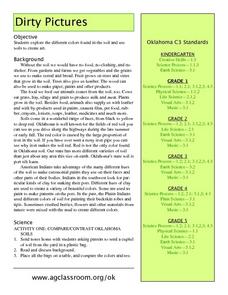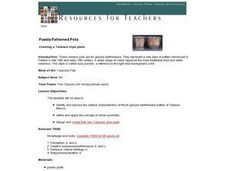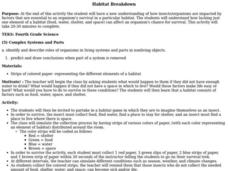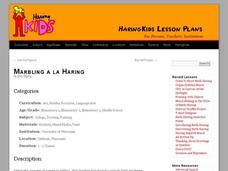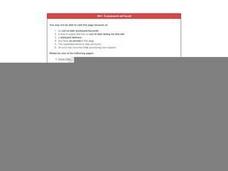Curated OER
Learning By Bees
Students investigate learning by bees as related to vision and foraging behavior. The experiment is done outdoors where bees are foraging for food. They make their observations and record their data which is shared with the class.
Curated OER
Dirty Pictures
Students investigate how food, clothing and shelter come from soil after they examine soil from their own backyards. They map soils on the color wheel before making glue and soil pictures and tie-dying T-shirts in red soil.
Curated OER
Enlightening Explorations, Part III
Sixth graders continue their examination of light. In groups, they make rainbows and examine the spectrum of visible light. They travel between various stations recording their observations about the behaviors of light. To end the...
Curated OER
The Sky Show
Young scholars use lecture and research to answer the question: Why is the sky blue? students research a variety of other sky phenomena, chart their observations and participate in experiments.
Curated OER
Clouds as Art: Torn Paper Landscape
Students create a torn paper landscape and use it to study clouds. In this cloud study and art lesson, students make a background art image from torn paper. Students create a torn paper landscape and use cotton balls to illustrate...
Curated OER
Puebla Patterned Pots
Sixth graders examine and discuss the characteristics of tin glazed earthenware pottery of Colonial Mexico. They design and create their own Talavera-style plate by applying the concept of radial symmetry.
Curated OER
Marbling Madness
Students create marbled prints by dipping paper through starch and acrylic paint.
Curated OER
Estimating Fish Populations
Students describe the mark/recapture method used to estimate fish populations. They explain the importance of being able to predict population numbers.
Curated OER
Oregon Rainshadows
Students brainstorm list of possible highest locations in Oregon, identify and label places from list on map using color code, and discuss and identify causes of a rain shadow.
Curated OER
Speleothem Formations
Students examine how speleothem formations can be simulated. Students follow directions carefully in this laboratory experiment, and keep a written account of everything they observe. After five days, the students share their experiment...
Curated OER
Diffusion of Molecules
Learners study the process for diffusion of molecules. In this chemistry lesson, students understand molecular movement, develop skills for a chemistry investigation, develop skills in making hypotheses, develop observational skills, and...
Curated OER
Habitat Breakdown
Fourth graders gain an understanding of how insects/organisms are impacted by factors that are essential to an organism's survival in a particular habitat. They see how lacking just one element of a habitat can affect an organisms chance...
Curated OER
Chemical Volcano
Students observe a demonstration performed by the teacher. They examine of a series of acid/base reactions and discover how various indicators work.
Curated OER
Habitat Is Home
Students are introduced to the concept and components of a habitat. They discuss the key components of a habitat and describe how certain factors can cause disturbances in a habitat and change its population. Activities are leveled for...
Curated OER
Marbling A La Haring
Students create a paper marbling painting based on the work done by Keith Haring. In this paper marbling lesson plan, students create abstract compositions and create a small mural with one another of their interlocking shapes.
Curated OER
Kitchen Cleaners
Students, in groups, select two cleaning agents that they feel solves their cleaning problem.
Curated OER
Checkerboard
Students create checkerboards using paints, glue, rulers, and masking tape in this upper-elementary/middle level Art activity. The activity emphasizes the history of checkerboards, strategies and rules, and the checkerboard as an...
Curated OER
Current Interactions
Students design an experiment to see how wind, temperature, and salinity work together to influence ocean currents and present it in a report format. They explain to their classmates how experiment findings relate to ocean currents.
Curated OER
Parts Per Million
Young scholars perform serial dilution of food coloring experiment with partner, examine concentration levels, and differentiate parts per million (PPM) and parts per billion (PPB). Students complete pre-lab and post-lab questions and...
Curated OER
What We Read About
Learners examine current events and create an artistic image that portrays the feelings brought forth by these readings.
Curated OER
Making Layered Hail Stones
Students explore how hail forms in the atmosphere, why hailstones are layered, and what accretion is. They also learn what supercooled liquids are.
Curated OER
Mater Your Munchies
Students explore the various food groups while doing a physical activity.
Curated OER
Wind
Fourth graders watch an experiment that demonstrates the causes of wind. They design and make an original weather craft.



